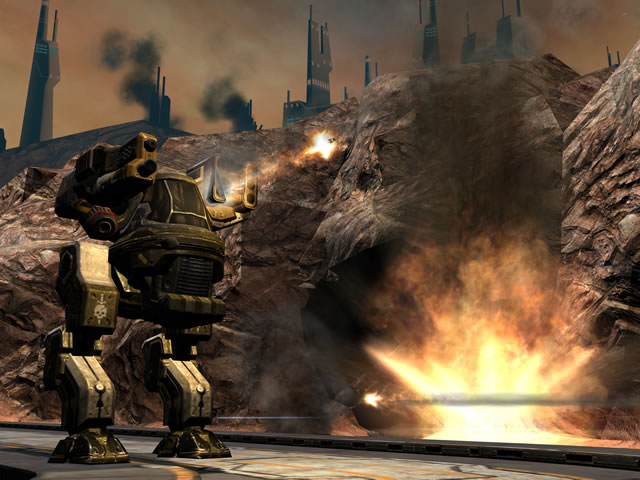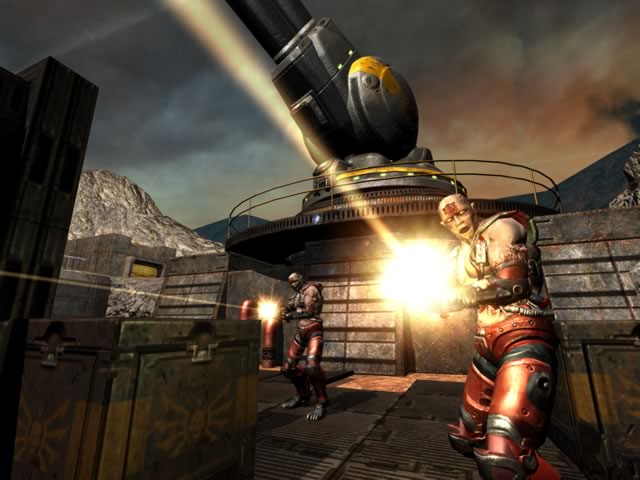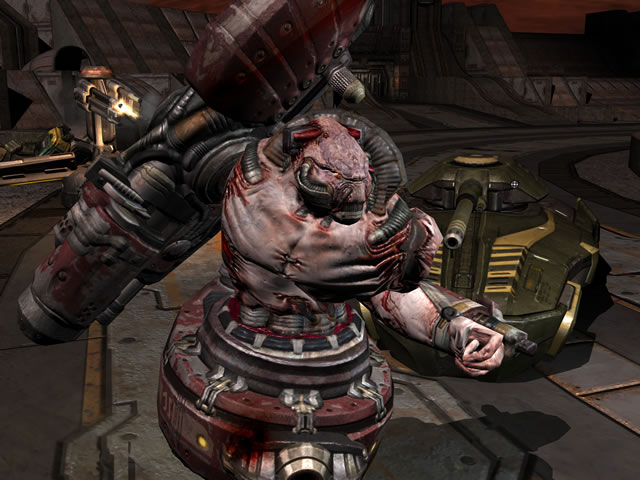Shaken, but not stirring.
I was pretty excited when Mike Tyson returned to boxing after his prison term. I vividly remembered the way he used to murder-ize opponents with vicious flurries of hooks and uppercuts and couldn’t wait to see another one of those performances live. Unfortunately, the only part of him that came back was the crazy, and after watching what Lennox Lewis did to him, I almost wished that he’d stayed in jail.
Likewise, the Quake series was off shelves nearly as long as Mike Tyson was in the clink, and its return meets with similar results. Quake IV tries to fall back on its bread and butter moves from the last decade, but this old champ just can’t keep up with the contenders.
The single-player campaign picks up where Quake II left off, with human forces pressing an all-out attack on the Strogg home planet after a lone marine killed their leader. As Matthew Kane, another heroic marine, you lead another crew of soldiers against the grotesque alien hordes. Don’t let that fool you, though – there’s no squad-based anything here. It’s still just you takin’ it to the Strogg like the Army of One you’ve always been in Quake games.
Quake IV tries to switch things up a little with a plot twist that turns you into the very thing you incessantly frag – a Strogg – but even after your transformation you’re just a dude with guns killing aliens, now with more health and faster movement speed. Ravensoft, the game’s developers, really should have turned the series completely back on itself, pitting you against humanity as one of the repossessed agents of industrial evil you always fought against.
Even the humans you occasionally run into don’t seem taken aback by the fact that a pal they were chatting with just an hour earlier now looks exactly like the enemy, bursting with all sorts of nasty tubes and machinery. Then again, with their plastic looking skin and rigid mannerisms, the NPCs hardly have room to judge. Even worse, they only come in two flavors: movers and chatters. The movers simply pace back and forth, telling you they’re busy if you question them. The talkers usually engage each other in some interesting conversations (you never have any dialogue options), but after they finish they just stand there staring at each other. It’s pretty creepy.
Your buddies do try to help out by shooting at the Strogg and healing you or giving you extra armor, but that all feels like part of the scripting rather than actual A.I. at work. Despite this nod to squads, it’s really just you versus the world.
Besides, you’ll feel more at home running through corridors and blasting aliens than hanging out with your paranoid friends. In fact, you’ll feel a little bit too comfortable, because Quake IV‘s single-player is much like a million other first-person shooters. You walk down a hall, open a door, kill the enemies, rinse, wash, get in a vehicle fight and repeat.
Like the friendly NPCs, there are two types of enemies – those that charge and those that don’t. This binary A.I. makes traveling through the game a snap. You just draw the chargers out into territory you’ve already cleared, kill them, and then pick off the rest at your leisure. If you get surprised and take a big hit, you can always quick-load and avoid the bushwhacking. When you have some open space to work with instead of corridors, life is even easier. Evidently, the Strogg, with all their advanced technology, haven’t invented an answer for the circle-strafe.
 Still, killing them is good fun. You have the usual assortment of Quake guns, including a chargeable pistol, assault rifle, shotgun, grenade launcher, rocket launcher, nail gun, plasma gun, rail gun, lightning gun and BFG (dark matter gun). The problem with most of these is that you have to shoot your enemies like the NYPD to bring them down, and headshots don’t seem to work. The only gun that really kills foes dead early on is, ironically, the shotgun – the least advanced weapon in your arsenal.
Still, killing them is good fun. You have the usual assortment of Quake guns, including a chargeable pistol, assault rifle, shotgun, grenade launcher, rocket launcher, nail gun, plasma gun, rail gun, lightning gun and BFG (dark matter gun). The problem with most of these is that you have to shoot your enemies like the NYPD to bring them down, and headshots don’t seem to work. The only gun that really kills foes dead early on is, ironically, the shotgun – the least advanced weapon in your arsenal.
As you progress you’ll receive various weapon upgrades, making the guns more proficient at taking out massive numbers of enemies as well as just plain massive enemies. The lightning gun gains a chain effect, the rocket launcher loads three rockets instead of one, and the nail gun gains a homing effect. While the game never becomes any less mindless, it at least gets more violent and varied.
Something we should also mention is the fact that the pistol and machine gun come with mounted flashlights, while the rest of the guns do not. This is more important early on, as you’ll fight enemies in some pretty dark quarters and the flashlight is a big help. Later, though, your enemies will be big and glowing, so spotting them won’t be such an issue.
The vehicles provide a welcome change of pace, especially the hover tank. No longer bound by such constricting corridors, you move fast and find yourself in nice open areas with lots of enemies to run over and shoot. Instead of simply back-pedaling and blasting away, here you’ll wildly lob tank shells while dodging enemy rockets.
But even with such an alternative gameplay style, the single-player game is so old-school and linear it’s silly. You’ll be reminded of carnival haunted houses as you sweep down corridors, quickly dispatching the enemies who spring around corners as you step on this or that floor panel. There are several segments where you’re literally stuck to a rail, either watching things happen or shooting the hapless enemies that charge you and your mounted cannon. If you’re old enough to be genuinely excited about a new Quake game, nothing here will entertain you for long.
 That goes for the multiplayer, too, which is pretty much unchanged from Quake III (which came out in 1998). You frag opponents and capture flags in wacky environments full of weapons, power-ups and launch pads that bounce you around like a pinball. There is no new take on the old formula whatsoever, just some new maps and guns, and you’re still instantly wielding any gun you happen to run over. Kicking ass with the rocket launcher only to have a rail-gun pop into my hands is an unpleasant surprise every time. I can’t believe they didn’t fix this.
That goes for the multiplayer, too, which is pretty much unchanged from Quake III (which came out in 1998). You frag opponents and capture flags in wacky environments full of weapons, power-ups and launch pads that bounce you around like a pinball. There is no new take on the old formula whatsoever, just some new maps and guns, and you’re still instantly wielding any gun you happen to run over. Kicking ass with the rocket launcher only to have a rail-gun pop into my hands is an unpleasant surprise every time. I can’t believe they didn’t fix this.
The only thing that isn’t six-years old is the game’s look. Using a modified version of the Doom 3 engine, Quake IV is a graphical monster. The enemies are terrifying, the environments richly detailed, the lighting superb and the framerate blazing. The background environments are much more alive than many first-person shooters; watching hundreds of brightly colored drone robots hover past a window is a lot more exciting than the typical horizon lines. It takes a good rig to get it looking right, but provided that’s not an obstacle, this is a pretty game.
It also sounds good. The music is dark and foreboding, but lacks the industrial perversity that made the game so distinct back when Trent Reznor provided the soundtrack. The voice work is great and the weapons, explosions and roars all sound perfectly chaotic and violent.
But in typical Strogg fashion, Ravensoft has taken a long-dead game, Quake III, and retrofitted it with the cogs and gears of a new era. The result is more sad than monstrous, a beast you’ll put down not with hate, but pity. You’d be far better served dipping into the likes of F.E.A.R. than treading down this overgrown path again.
-
Straightforward, violent fun
-
Good weapons and vehicles
-
Looks great
-
Rehashes Quake III
-
Linear, unoriginal campaign
-
Tepid multiplayer











